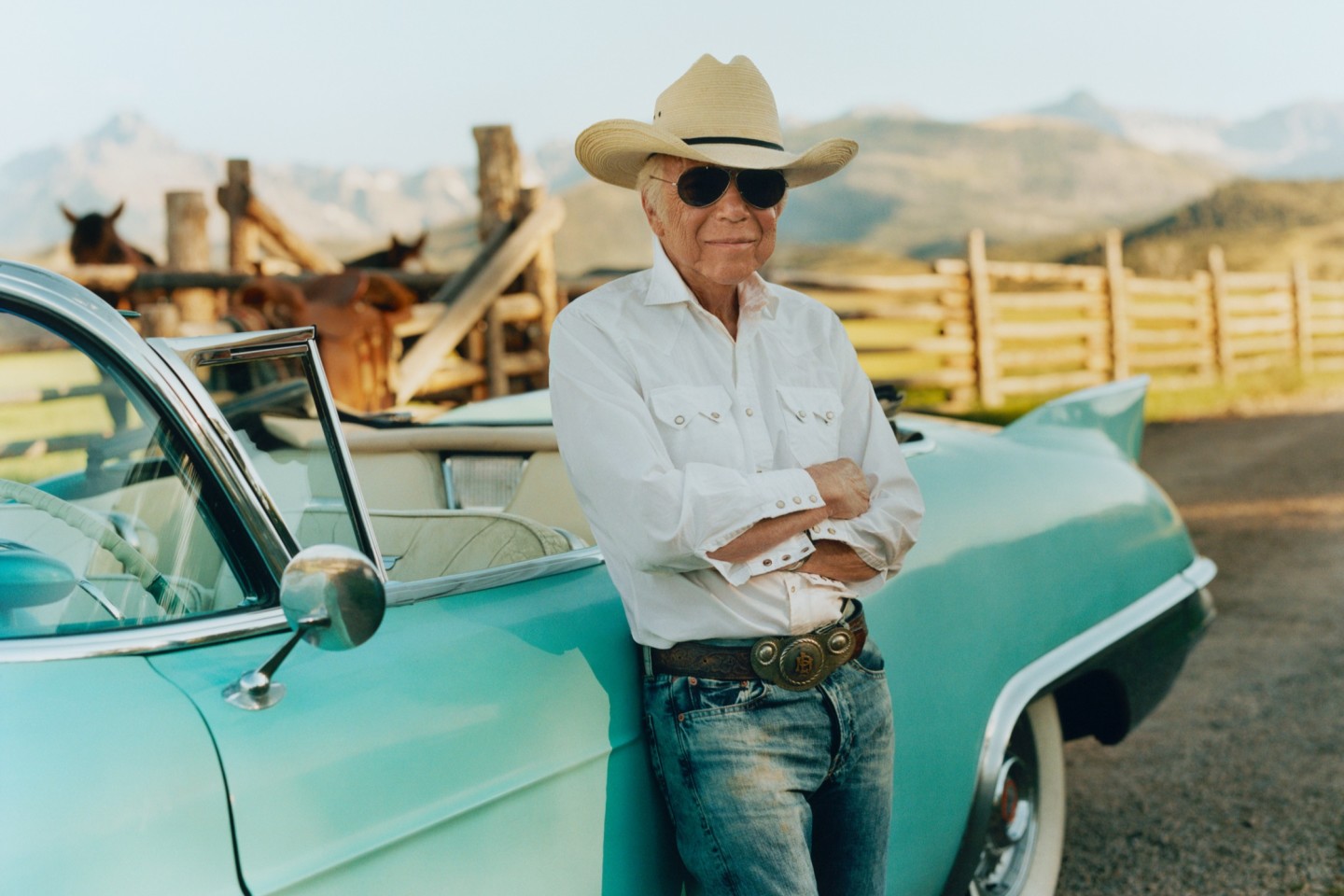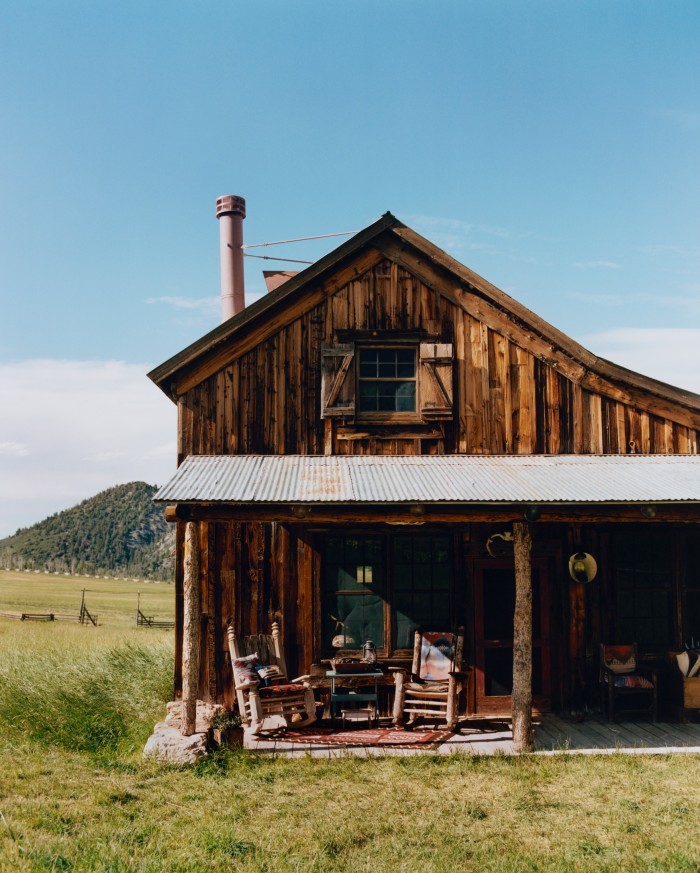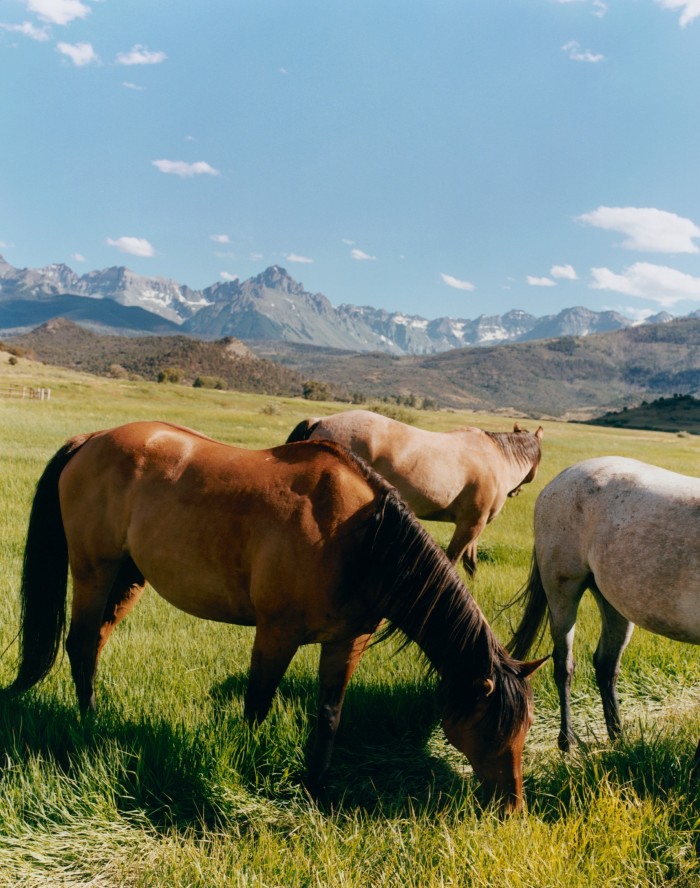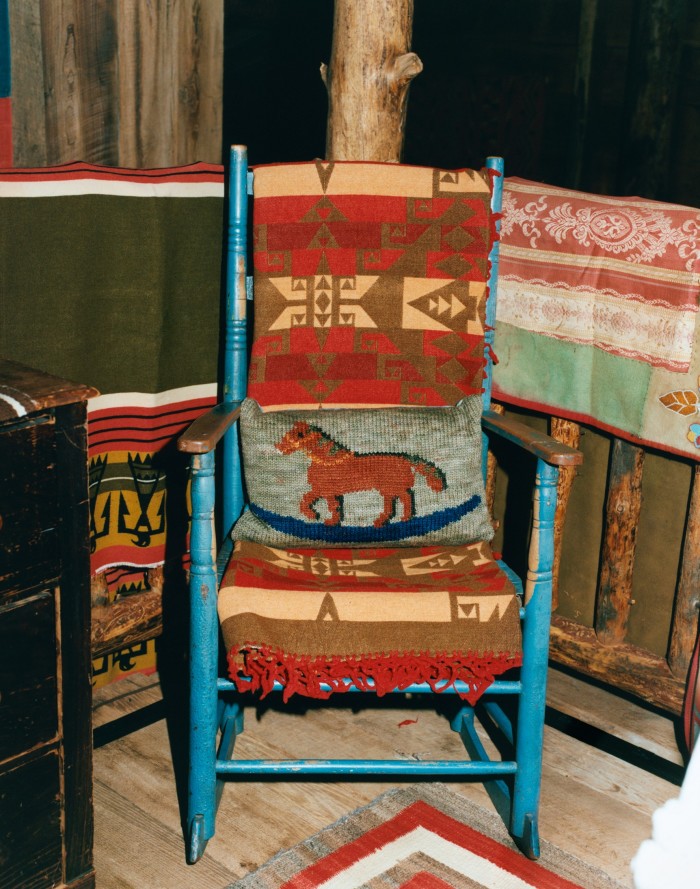On the ranch with Ralph Lauren

Simply sign up to the Fashion myFT Digest -- delivered directly to your inbox.
In the last scene of the pilot episode of the TV series 1883, Academy Award-nominated director Taylor Sheridan’s wildly popular prequel to Yellowstone, a young girl stands on a lush riverbank as the golden-hued sunset illuminates concentric circles on the water’s edge. She dances on the shoreline, the outline of her figure accentuated by her perfectly cut white cotton sundress with a frilly pleat at the leg, and then dives in headfirst. The background music swells. “I wish I could freeze this moment,” she says over the orchestral strings. “I would live in it forever... swimming in the possible while the mud of the real is stuck to the shore.”
I think of this phrase while sitting across from the fashion designer Ralph Lauren at his Double RL Ranch (named after Lauren and his wife, Ricky) in Colorado. Lauren is a fan of 1883, and it’s not hard to see why. A similar landscape of streams and open fields composes the nearly 17,000-acre property (“bigger than Manhattan”, Lauren tells me with a smile), all set against the San Juan mountain range. The cowboys on the ranch tend to 1,000 head of cattle, whose meat is used for Lauren’s famous burgers and steaks at The Polo Bar in New York and for suede boots and bags for the vintage-inspired Double RL line he started in 1993. The wooden fence that encircles the ranch is the stuff of local legend, commented on by vacationers to Telluride, and even Oprah Winfrey, who has a house on the mountain nearby.


It’s a blustery day in August, the wind swirling around the thigh-high grass and onto the wraparound porch of The Saloon, a modestly sized log cabin that’s part living room, part dining room and bar, with its own private cinema whose screen is swagged in a crimson velvet curtain like a Vaudeville IMAX with rows of distressed leather club chairs. “It’s always like a movie,” Lauren says, as he ushers me inside. He is wearing faded blue denim jeans, a white cotton Henley, matching denim jacket and grey New Balance trainers. “It’s a movie that tells you a story that I want to express,” he continues. “If you just do clothes, it doesn’t mean as much. It’s like when you come onto the ranch wearing a chambray shirt – you know you look cool but it’s a different kind of cool, not fashion cool.”
Lunch is served: south-west-style burgers (what else?) with avocado salsa on a crisp tortilla “bun” (no first course; the man’s busy) and iced teas on a dining table set with a rustic magenta linen tablecloth, stone china and folded napkins with a single wildflower in place of a napkin ring. I look around. We could be 140 years in the past, in 1883, or in a Ralph Lauren ad. The only giveaway that we’re in the 21st century is one of his associates’ iPhones on the bar.
That’s the thing about Ralph Lauren and the worlds he creates. They’re all-encompassing. No detail is spared, yet nothing feels pastiche. As Vera Wang, who worked as an accessories designer at Ralph Lauren before starting her eponymous business, puts it: “Ralph has a unique brand that defies fashion. At its core, it is a truth many in our industry ignore, its elasticity, democratic yet aspirational.”


He’s a master of juxtapositions with a reverence for worn objects with patina. The places he creates are both of their time and exist out of time. That kind of temporal dissonance is probably what has made Ralph Lauren’s worlds so comforting for all these years. Lauren’s long-time friend, the director Steven Spielberg, knows this more than most. “The late Steven J Ross first introduced Ralph and I in the early 1980s and we hit it off immediately. In Ralph I recognised another storyteller. Fashion may be his medium, but there’s a conscious narrative behind every line of clothing he and his companies have designed, directed and produced,” says the director, who is often snapped in Lauren’s clothes. “Ralph has stood the test of time in the upper echelons of our constantly shifting culture, and has remained inventive, modern and relevant. We are both avid collectors of second world war Army Air Corps flight suits and flak jackets because I believe being kids of the Greatest Generation we are still just boys at heart.”


Time and timelessness are a recurring theme in his third book with Rizzoli, Ralph Lauren: A Way of Living, out this September. The book is an exhaustive 544-page Ralph-tannica of his homes and lifestyle collections, spanning the many varied worlds he has inhabited, from the Hamptons to the West Indies and Manhattan. The book, which marks the 40th anniversary of the first Ralph Lauren Home Collection in 1983, is dedicated to Ricky and their three children, Andrew (who does the music for Lauren’s shows), David (current Ralph Lauren chief branding and innovation officer), and Dylan (who founded the popular Dylan’s Candy Bar chain), and is divided into three sections: Homes, Lifestyles and History.
The Homes section dives into Lauren’s signature five abodes that he has lived in since his mid-30s (he’s remarkably never sold one). There is the sprawling Double RL ranch, dotted with period-style log-cabin structures, including the recently refurbished Vance Cabin, named after the original owners of the ranch (David Lauren wed Lauren Bush, a niece of president George W Bush, in the nearby Vance Barn); a 1940s low-slung beach house in Montauk (the easternmost beach town in New York’s Hamptons) built by a disciple of Frank Lloyd Wright; the baronial manse in Bedford, a tiny hamlet an hour’s drive from New York that also counts Martha Stewart and Daniel Boulud as residents; the Fifth Avenue penthouse in Manhattan overlooking the Jacqueline Kennedy Reservoir, which he purchased in the 1970s, and his villa in Round Hill, Jamaica. RL describes the place in his book as “the closest thing to heaven I think I can feel”.



Flipping through the pages, one is touched with nostalgia for this sartorial empire. Another thing comes to mind: how did one man have such great real-estate karma?
“I didn’t have it mapped out, I didn’t have a plan,” he assures me. “But I knew that I was going to do something. I had a dream. And it’s all the things you see, not just one thing,” he says of his multifaceted world, encompassing everything from the towel collections to his many fashion lines for men, women and children, to his popular restaurants and world-class car collection. One of the more amazing vehicles is parked nearby, a turquoise 1957 Cadillac Eldorado Biarritz convertible, referred to as a “cowboy Cadillac”, complete with a horse’s saddle casually hoisted in the backseat as if it’s on its way to the rodeo.


“You go on living, you have a family,” he says of building on his dream. “You live, and that’s what it’s about. If you’re living, how do you present yourself? How do you feel good about yourself? When you have an apartment, what makes you say: ‘I love this?’” he asks. “When I first got married, we lived in the Bronx. When we had children, I was aware of their lives and what they wanted. I was not stuck in time. I was always moving. As kids grow up, you see them get cooler and more sophisticated and life goes forward. I don’t like oldness. I like timeless. We achieved the houses that we wanted to, and the world that we wanted. Having the beach, having the ranch, it’s just another life. It was just different clothes, different dreams.”
The dream started humbly in 1967, when the Bronx-born Lauren sold ties out of a drawer (this was the pre-WeWork era) at the Empire State Building. They were wide, handmade ties, and considered unfashionably European. But Lauren persevered, and Bloomingdales, after rejecting him once, asked for a rack of merchandise to be displayed in the flagship store. He was 28 years old. The publicly traded company, which has more than 23,000 employees across the globe and announced around $6.4bn in revenue in 2023, had a tough time during the pandemic, but has since bounced back with a focus on its premium and luxury assortment.
But what happens when you have everything you want? “The dream is deeper,” Lauren acknowledges. He keeps going, always channelling “a writer or cinematographer”. In the chapter “Bohemian”, he creates a Ralph avatar because “creating collections is about telling stories, imagining characters and how they live”. In the chapter “Speed”, Lauren describes how the channel-stitched leather of his 1955 Mercedes-Benz Gullwing Coupé was the inspiration for a headboard in one of his collections, and the carbon fibre in his 1996 McLaren F1 informed the design of his carbon-fibre chair, the RL-CF1. The last section, “History”, is a Ralph Lauren timeline with images and quotes from luminaries including Hillary Clinton and Audrey Hepburn, and created for anyone who has studied (or who wants to study) at the School of Ralph.



Chocolate-chip cookies are served, Ricky’s recipe, along with a single mango, and we start to discuss the connection between all of Lauren’s worlds: sleek one minute, rustic the next. I read aloud something he’s written in the book: “I have never followed architectural rules or chosen one decorative theme. I don’t love just one thing. I love contemporary. I love American Country, the south-west and Bauhaus. I looked for things that made my heart race. I don’t care if a thing is English, French, antique or modern. It’s whatever appeals to my eye. It’s what works. I just care if it tells a story. I’m a romantic.”
“Confidence is really knowing who you are,” Lauren tells me. “I know who I am, so I can do what I want to do. I’m not waiting to see who’s doing it so I can do it.” I realise what Lauren has done probably better than anyone else is give us permission to be whoever we want to be. “Anybody who has been happy and successful in their life has believed in themselves,” he tells me with a pat on the back. “They’ve been willing to walk if they couldn’t do what they believed. That’s what I do.”
Comments